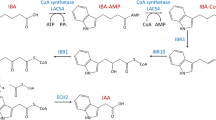Abstract
Dormancy break and germination requirements for Quercus pagoda (Raf.) acorns were determined, as well as the effects of acorn pretreatment and post-germination temperatures on epicotyl emergence, seedling development, and seedling biomass accumulation. There was an inverse linear relationship between length of cold stratification (5/1 °C for 0–12 weeks) and cumulative germination percentages in all incubation temperatures (15/6, 20/10, 25/15, 30/20 °C). Acorns required 12 weeks of cold stratification to break dormancy. Gibberellic acid substituted for cold stratification; although, it was not as effective as 12 weeks cold stratification. At 16 weeks of cold stratification, 20% of acorns had germinated, and the remaining 80% of ungerminated acorns reached ≥ 97 ± 1% cumulative germination within 4 days in all incubation temperatures. Post-germination time to epicotyl emergence and to leaf flush was a function of temperature, and time decreased with increased temperatures. With light held constant (50 μmol m−2 s−1), seedlings accumulated greater biomass in temperatures > 20/10 °C. Q. pagoda acorns possess Type 2 nondeep physiological dormancy, and this allows for artificial manipulation of timing and duration of germination. Extending cold stratification 4 weeks beyond dormancy break (i.e., 16 weeks) yields more uniform germination across a range of temperatures. Epicotyl emergence, seedling development, and biomass accumulation may be regulated by manipulating growing temperature. In this study, the most uniform seedling cohort with the greatest total biomass was produced when acorns received 16 weeks of cold stratification, followed by transfer of germinants to 30/20 °C.






Similar content being viewed by others
References
Allen R, Farmer RE Jr (1977) Germination characteristics of bear oak. South J Appl For 1:19–20
Baskin JM, Baskin CC (2004) A classification system for seed dormancy. Seed Sci Res 14:1–16
Baskin CC, Baskin JM (2014) Seeds: ecology, biogeography and evolution of dormancy and germination, 2nd edn. Elsevier, Academic Press, San Diego
Bonner FT (1982) The effect of damaged radicles of presprouted red oak acorns on seedling production. Tree Planters Notes 33:13–15
Bonner FT (1993) Storing red oak acorns. Tree Planters Notes 24:12–13
Bonner FT (1996) Responses to drying of recalcitrant seeds of Quercus nigra L. Ann Bot 78:181–187
Bonner FT, Vozzo JA (1987) Seed biology and technology of Quercus. General technical report SO-66. U. S. Department of Agriculture, Forest Service, Southern Forest Experiment Station, New Orleans
Connor KF (2004) Storing acorns. Native Plants J 5:160–166
Connor KF, Sowa S (2003) Effects of desiccation on the physiology and biochemistry of Quercus alba acorns. Tree Physiol 23:1147–1152
Corbineau F, Dacher F, Côme D (2001) Effects of cold storage duration of acorns and of germination temperature on seedling development in sessile oak. Rev For Fr 53:32–43
Crow TR (1992) Population dynamics and growth patterns for a cohort of northern red oak (Quercus rubra) seedlings. Oecologia 91:192–200
Dey DC (2014) Sustaining oak forests in eastern North America: regeneration and recruitment, the pillars of sustainability. For Sci 60:926–942
Dey DC, Gardiner ES, Schweitzer CJ, Kabrick JM, Jacobs DF (2012) Underplanting to sustain future stocking of oak (Quercus) in temperate deciduous forests. New For 43:955–978
Farmer RE Jr (1977) Epicotyl dormancy in white and chestnut oaks. For Sci 23:329–332
Gardiner ES, Hodges JD (1998) Growth and biomass distribution of cherrybark oak (Quercus pagoda Raf.) seedlings as influenced by light availability. For Ecol Manag 108:127–134
Hawkins TK (2003) A comparative life history study of six species of Apiaceae of the eastern North American deciduous forest, with particular reference to biomass allocation. Dissertation, University of Kentucky
Hopper GM, Smith DW, Parrish DJ (1985) Germination and seedling growth of northern red oak: effects of stratification and pericarp removal. For Sci 31:31–39
Krinard RM (1990) Quercus falcata var. pagodifolia Ell. Cherrybark oak. In: Burns RM, Honkala BH (Tech Coord). Silvics of North America, vol 2, Hardwoods. USDA Forest Service agriculture handbook 654. USDA Forest Service, Washington, pp 640–649
McCartan SA, Jinks RL, Barsoum N (2015) Using thermal time models to predict the impact of assisted migration on the synchronization of germination and shoot emergence of oak (Quercus robur L.). Ann For Sci 72:479–487
Oliet JA, de Castro AV, Puértolas J (2015) Establishing Quercus ilex under Mediterranean dry conditions: sowing recalcitrant acorns versus planting seedlings at different depths and tube shelter light transmissions. New For 46:869–883
Peterson JK (1983) Mechanisms involved in delayed germination of Quercus nigra L. seeds. Ann Bot 52:81–92
Poulsen KM, Eriksen EN (1992) Physiological aspects of recalcitrance in embryonic axes of Quercus robur L. Seed Sci Res 2:215–221
Putnam JA, Furnival GM, McKnight JS (1960) Management and inventory of Southern Hardwoods. USDA Forest Service agriculture handbook 181. USDA Forest Service, Washington
SAS Institute Inc. (2007) The SAS system for Windows, release V9.2. SAS Institute, Cary
Stokes P (1965) Temperature and seed dormancy. In: Ruhland W (ed) Encyclopedia of plant physiology, vol 15, part 2. Springer, Berlin, pp 746–803
Acknowledgements
The author thanks Rory Thornton for help with data collection, the Mississippi Forestry Commission for permitting acorn collection at Winona Seed Orchard, and Dr. Charles Sabatia, Dr. Jeffrey Walck, and Dr. Siti Hidayati for review of an earlier draft of this manuscript.
Author information
Authors and Affiliations
Corresponding author
Rights and permissions
About this article
Cite this article
Hawkins, T.S. Regulating acorn germination and seedling emergence in Quercus pagoda (Raf.) as it relates to natural and artificial regeneration. New Forests 50, 425–436 (2019). https://doi.org/10.1007/s11056-018-9667-z
Received:
Accepted:
Published:
Issue Date:
DOI: https://doi.org/10.1007/s11056-018-9667-z




